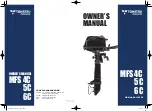
13-13
• CYLINDER HEAD SURFACE WARPAGE
1) Take care not to damage (score, scratches, etc.) the mating
surface with the gasket.
2) Measure the surface warpage using a straight edge and a
feeler gauge as shown.
• CONNECTING ROD BEARING OIL CLEARANCE
1) Clean the crank pin and the connecting rod bearing. Check
the crank pin and the bearing for damage and wear.
2) Install the crankshaft on the cylinder block. Install the
connecting rod cap on the connecting rod and tighten the
connecting rod bolts to the specified torque (P. 13-22).
3) Remove the connecting rod cap. Set a plastigauge on the
crank pin.
• Set the plastigauge in the axial direction.
• Tighten the connecting rod bolts with care not to turn the
crankshaft and connecting rod.
4) Reinstall the connecting rod cap and tighten the connecting
rod bolts to the specified torque (P. 13-22).
5) Remove the connecting rod cap. Measure the pressured
width of the plastigauge using the scale printed on the bag
of the plastigauge.
Measure the widest width on the plastigauge.
NOTICE
NOTICE
[1]
PLASTIGAUGE
[1] PLASTIGAUGE
[2] SCALE
STANDARD
SERVICE LIMIT
0.07 mm (0.003 in) Max.
0.10 mm (0.004 in)
STANDARD
SERVICE LIMIT
0.032 – 0.066 mm
0.077 mm
(0.0013 – 0.0026 in)
(0.0030 in)
6) If the measurement exceeds the service limit, check the
connecting rod big end I.D. and the crank pin O.D. If they
are OK, replace with the undersize bearing by referring to
the connecting rod bearing selection table (P. 13-16), and
measure the oil clearance again.















































